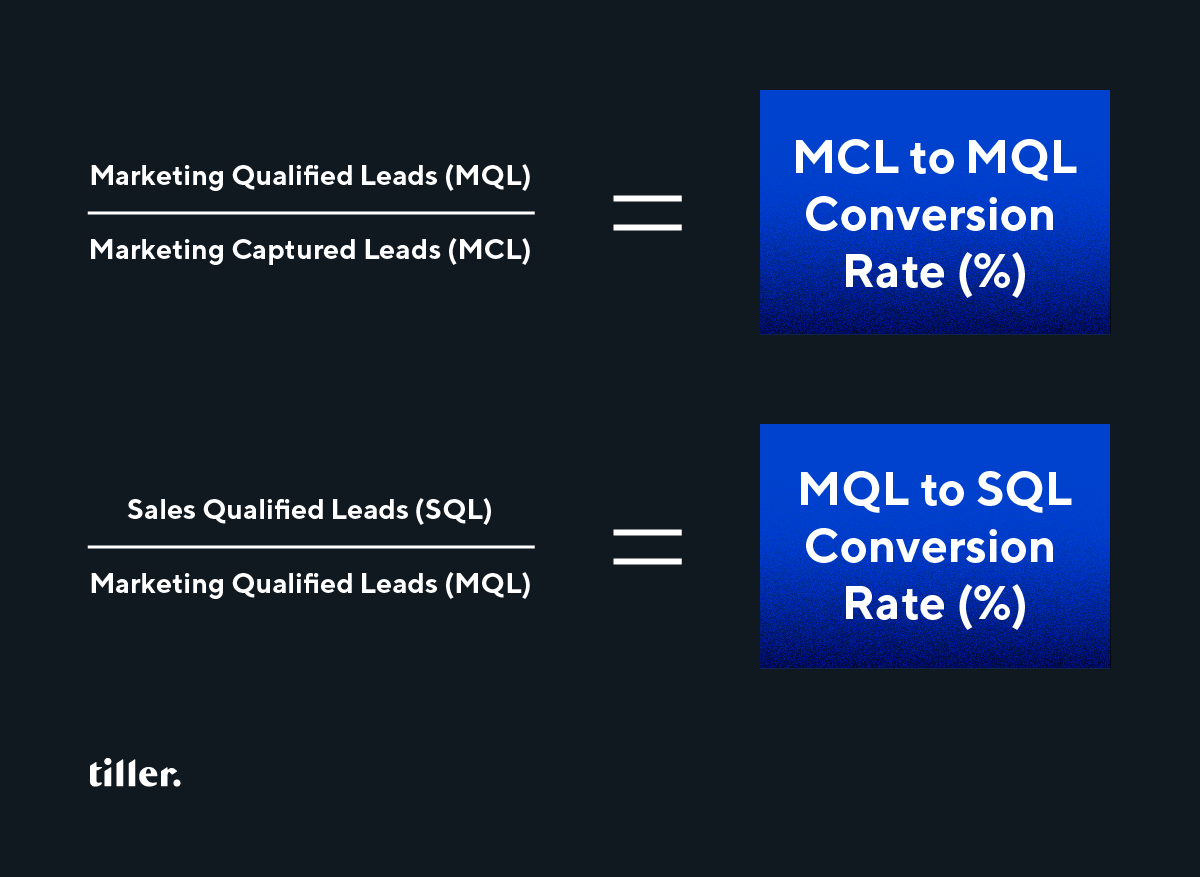What is an MCL vs MQL vs SQL? And why do they matter?
Leads. You want them. You love them. But are you really making the most of them? Tracking, qualifying, and analyzing leads is critical to business success, yet many marketers are only getting half the data they need. Without the full story, you miss out on valuable marketing and sales insights that can take a SaaS company from hanging on to taking off.
Let’s talk leads
While different companies adopt their own lead categorization, leads generally fall into three categories:
- Marketing captured lead (MCL)
- Marketing qualified lead (MQL)
- Sales qualified lead (SQL)
What is a marketing captured lead (MCL)?
A marketing captured lead is any lead that could become a future customer but has not yet been qualified as a good fit for your business. There are all kinds of ways to capture leads:
- Website
- Demo request
- Free trial sign up
- Resource download
- Email newsletter signup
- Live chat or chatbot conversation
- Ads
- Search ad click
- LinkedIn ad click or resource download
- Direct referrals
- Word-of-mouth referrals
Marketing captured leads can enter any stage of your funnel. They might be months out from making a purchase decision but are interested in your thought leadership content. Or they might have already completed their vetting process and have the intent to buy.

Why you need to track marketing captured leads
Marketing captured leads tell you how many leads you’re getting and where you’re getting them from. They confirm that you’re generating leads from diverse channels and highlight which channels are performing best. Without tracking MCLs, you could be overinvesting on a channel that isn’t producing any leads.
While MCLs don’t indicate whether leads are a good fit for your business (read on to MQLs), they lay the foundation for all other lead generation data and conversion rates.
What is a marketing qualified lead (MQL)?
A marketing qualified lead is a lead that has expressed interest in your offering but hasn’t indicated they’re ready to buy. As the name suggests, MQLs must be qualified against pre-defined criteria to ensure they would be a fit for your company.
Qualifying factors will vary by business but could include geographic location, demographics, business type, company size, etc. This information can be gained through forms, web analytics, and ZoomInfo (or tools like it). Qualification should always be handled in your CRM and easily accessible to your marketing and sales teams.
Once you’ve identified your MQLs, you can segment and nurture them to become sales qualified leads (SQLs). Email newsletters, drip campaigns, and targeted ads are just a few marketing tactics you can use to create urgency and draw leads further into the funnel.
Why you need to track marketing qualified leads
Tracking MQLs will make you a more effective marketer. They tell you how many of the right leads you’re attracting. You might have a large volume of MCLs, but you won’t know if they’re a good fit until you qualify them.
If MQLs are high, you gain confidence in your marketing strategy and tactics. You’re attracting businesses that fall within your ideal customer profile (ICP) and sending high-quality leads to Sales.
If MQLs are low, you may need to re-evaluate your marketing approach. Ask questions like:
- Is your messaging speaking to the right audience?
- Are there qualifying questions you could add to your forms to weed out businesses outside of your ICP?
- Are you focusing your marketing efforts on the channels your ICP uses most?
With consistent tracking and lead scoring, you’ll be better equipped to optimize your marketing methods and set your sales team up for success.
What is a sales qualified lead (SQL)?
A sales qualified lead is a lead that has expressed interest in purchasing your product. They have progressed through the funnel, entered the sales cycle, and appear to be getting ready to buy.
In SaaS, SQLs often engage through your website. They may submit a Get Demo form or start a free trial. Sales qualified lead criteria is typically more specific than MQLs — not only do they fall within your ICP, but they are showing signs that they are ready to buy. These details and buying signals should all be documented in your CRM.
Now, businesses all need their own definition of an SQL. At Tiller, we classify sales qualified leads as qualified leads that have also asked for a proposal. Our SQLs have one-on-one conversations with our sales team and are actively progressing through the sales process. We’ve intentionally narrowed our SQL criteria over time to ensure we’re only creating proposals for high-potential customers.
Why you need to track sales qualified leads
Sales qualified leads help you understand your sales pipeline, typical buying cycle, and future revenue potential.
For service-based businesses, a high volume of SQLs may indicate you need to bring on more resources to deliver the work. A lack of SQLs could mean sales and marketing need to collaborate on lead generation strategies.
For product-based businesses, a high volume abundance of SQLs may indicate you’re targeting the right ICP and your product is gaining traction in the market. A lack of SQLs could mean your value proposition isn’t landing the way you think and you need to revisit messaging and marketing strategies.
If you aren’t tracking SQLs, you’re in trouble. You have leads in your pipeline but no visibility on whether they’re the right fit or if they’re likely to close. You could be building a ton of proposals, but nobody is buying.
And of course, without SQLs, you aren’t able to calculate your MCL to MQL to SQL conversion rate. You’re left guessing about marketing performance and have limited data to inform marketing decisions.
How to calculate MCL to MQL and MQL to SQL conversion rates
If you are tracking MCLs, MQLs, and SQLs, well done! You have the data you need to calculate your conversion rates. You can figure out the number of the percentage of leads that have a high potential to turn into revenue.
We often hear people talk about their MQL to SQL conversion rate. But without the marketing captured leads, you’re missing out on the full story. Here’s what we recommend to our clients:
Calculate your MCL to MQL conversion rate to learn what percentage of all captured leads fall within your ICP.
Then calculate your MQL to SQL conversion rate to learn what percentage of marketing qualified leads actually enter the sales cycle.
If you want to learn even more, look at how many SQLs are actually converting into revenue.

Beware of vanity metrics
There will always be the temptation to try to make your numbers and conversion rates look good.
Don’t.
MCLs, MQLs, SQLs, and conversion rates are powerful tools in your marketing toolbox. When leads are tracked properly, they can reveal gaps in your marketing strategy and help you pinpoint where to take action.
Don’t write an inaccurate narrative by reporting lead generation data in isolation. Any data point on its own is high risk. If you report your high volume of MCLs to your executive team but company revenue has gone down, you’re going to be in a very awkward spot.
Vanity metrics promote inaction; an inflated pipeline makes you take your foot off the gas. It makes us think we’re accomplishing more than we are. But the numbers will always come out in the end. So instead of focusing on the number that looks the best, zoom out and analyze all data points at once. We also find that being intentionally conservative in your forecasts tends to incentivize performance.
We get it. Tracking can be uncomfortable. It shows you the real data, which may show that you’re falling short of the goals. But the wonderful thing is, then you can do something about it.
MCLs, MQLs, SQLs, and conversion rates are individual puzzle pieces. It’s only when you put them all together that you get a clear picture of performance and know where to optimize for better results.
Key takeaways
- Track and analyze all lead generation data — don’t forget about the MCLs
- Get specific with your qualification — create MQL and SQL definitions for your business
- Don’t get tunnel vision — analyze all metrics in the context of each other
- Beware of vanity metrics — make the data as real as possible so the gap is clear
- Get comfortable with being uncomfortable — embrace the shortcomings, then get to work



